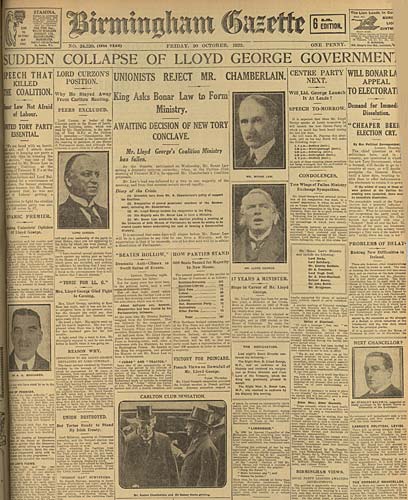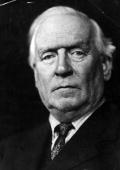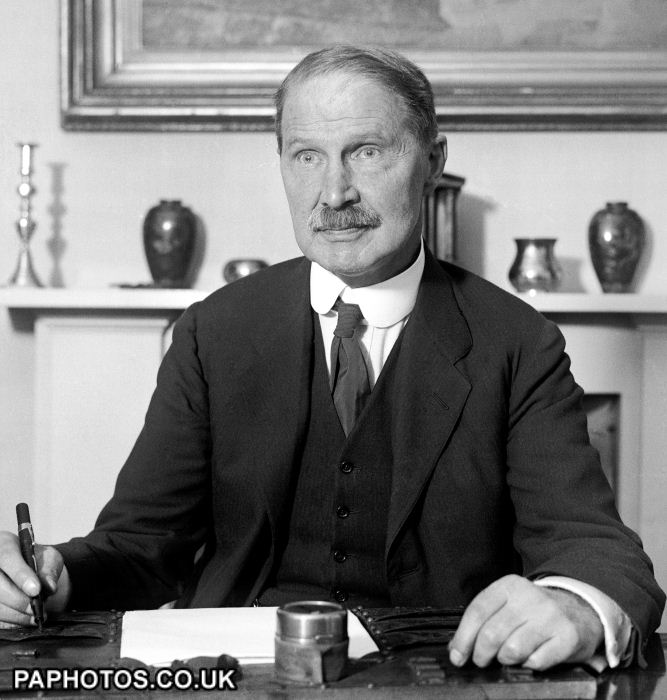by Pete Goddard and Atul Hatwal
“Thanks for winning the last election for us,” said the Tories to Lloyd George, “now bugger off.”
After cheerfully defenestrating their Liberal coalition partner, they installed Andrew Bonar Law in October 1922 as the new prime minister. Law immediately fired the starting gun on the general election, setting the 15th November as the date for the poll.

The Birmingham Gazette demonstrates the range of visuals that made their picture desk the envy of the world
Unfortunately, he forgot to mention this to his own party’s campaign machine, which was taken by surprise when the poll was announced.
Wrong-footed, they hurriedly selected candidates, grabbed a handful of key words from “Attacking Labour for Dummies” and rushed a selection of posters to the printers with the instruction “Anything with words ‘tax’, ‘socialism’, ‘debt’ and ‘spending’ is fine”.
The Liberals weren’t wrong-footed because they were too busy imploding.
Lloyd George and Herbert Asquith were competing for the soul of the Liberal party, having misread the wisdom of Solomon and concluded it was actually a good idea to cut the baby in half.
In an effort to confuse the electorate, they led parties named the National Liberals and the Independent Liberals respectively – the chief difference between the two being whose picture was on the front of the manifesto.

Herbert Asquith - you can lead all of the Liberals some of the time, or some of the Liberals all of the time…
To further baffle voters, in some seats, Liberal candidates stood calling for unity between the two chiefs, in some they stood backing both and in others every variety stood, all opposing each other.
By way of contrast, in the red corner, for once Labour was ready.
Despite a relatively unimpressive previous four years, when the party saw little success in preventing unprecedented government cuts and soaring unemployment, the party was still self-confident enough to know that this was its big opportunity.
And they were prepared to go it alone.
This was clearly seen at the annual party conference in January, where two motions had been resoundingly carried.
The first was a response to the communists, who wanted to affiliate to the party and create a broad front of leftist opposition, an early Peoples Assembly Against Austerity. The response was “Get stuffed, commies.”
At a stroke the communists’ hope for a united opposition were dashed, as indeed were their chances of acquiring a nifty vehicle for entryists to take control of the Labour party.
The second motion was to give much the same message to those people considering a deal with the Asquithite Liberals to ensure the anti-Tory vote in marginal seats wasn’t split. This group did not have a name, because Compass hadn’t been invented yet.
Meanwhlie, out in the country, the party prepared for an election battle.
The election machine, barely constructed in 1918, was fully operational with organised lists of volunteers and canvassers, centrally produced campaign materials and a car with a big speaker on the top.
The newly formed constituency parties had been busy too, selecting candidates. Lots of them. Labour ultimately contested two thirds of the seats, running candidates in 414 seats, a significant increase from 361 in 1918, forcing the party to sell the convertible and buy a people carrier instead.

Everyone marvelled at JR Clynes’ ability to sport grey hair and a moustache yet still look like a teenager
These unprecedented levels of preparation were also visible in the party’s policy platform.
The 1922 party manifesto marked a significant departure to Labour’s previous efforts. Rather than a general ‘vote Labour for, er, nice things to happen’, it tackled Labour’s main weakness specifically and head on.
It was obvious that the Tories’ main line of attack would be the danger of Labour ramping up the national debt (which at the time had just topped 160% of GDP, about the same as Greece today).
Rather than just ignore this and try to talk about something easier like welfare, housing or kittens the party formulated a detailed response.
The key section in the manifesto was plainly entitled, “How to find the money.”
In this, Labour proposed a suite of policies to delve down the back of the national sofa and dig out the funds to tackle the debt. These would enable the creation of a specific fund called the “war debt redemption fund”.
There was a graduated wealth tax on “fortunes over £5,000” meaning savings of an amount worth over £240,000 in today’s money. There was an increase in death duties for large estates. There was a super-tax on the highest incomes, taxation of land values and a commitment to reforming the tax system so it better reflected peoples’ ability to pay.
On the other side, the party found the room for some fiscal stimulus too. It offered a tax cut for people on £250 or less each year (£12,000 at today’s prices) and a guarantee that anyone on an annual income of £500 (£24,000 today) or less would not pay any more in tax.
It was the party’s most comprehensive programme for a more equal society. For the first time, the party was campaigning on a national scale, with a policy offer that was more than just “vote Labour if you get your hands dirty at work.”
Its broad appeal, to both working and middles classes marked a new (New, even) Labour approach to elections: the party wasn’t just in it to be a working class pressure group, it was in it to win it.
In response, the Tory manifesto offered no specific policies other than a suspiciously New Age appeal for tranquillity (free Navajo dream catcher with every vote), and the more familiarly Tory plan for more, harder and deeper cuts.
The Tory vision was summed up in Bonar Law’s election address,
“Every Candidate, in every constituency, will, as I do, make retrenchment an essential part of his programme.”
Not exactly ‘yes we can’, was it?
The result was a major breakthrough. Ok, Labour didn’t actually win, so that part was familiar ground. But for the first time, it was competitive.
The Tories won on 344 seats, a majority of 36, but the real story was that Labour more than doubled its representation, rising from 57 seats to 142 seats.
The number of people voting Labour increased from 2.2 million in 1918 to 4.2 million in 1922.
Labour’s share of 29.7% of the vote in 1922 was higher than the party achieved in either 1983 or 2010.
At the end of the election, Labour had comfortably more MPs than the two Liberal factions put together (which, of course they weren’t. They were still bickering).
The party was firmly established as the alternative to the Tories and the notion of a Labour government, inconceivable just four years earlier, was now something that maybe, just maybe, could become a reality.
Pete and Atul are not historians
Tags: 1922 general election, Andrew Bonar Law, Atul Hatwal, Herbert Asquith, J.R.Clynes, Labour history uncut, Pete Goddard









